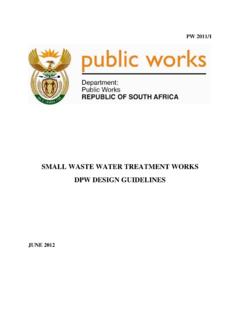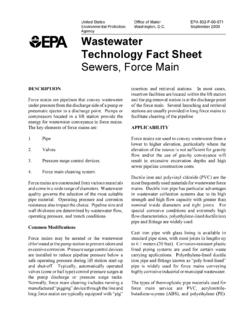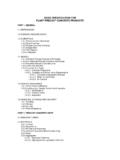Transcription of DESIGN AND CONSTRUCTION STANDARDS FOR SEPTIC …
1 Chapter 2. DESIGN AND CONSTRUCTION STANDARDS FOR SEPTIC TANKS, SOIL ABSORPTION SYSTEMS, AND. OTHER SMALL WASTEWATER SYSTEMS. Section 1. Authority. This regulation is promulgated pursuant to the Wyoming Administrative Procedures Act, 16-3-101. et seq.; the Wyoming Environmental Quality Act, 35-11-101 through 35-11-2004; and 35-1-301 through 35-1-309. Specifically, 35-11-301 states that no person, except when authorized by permit, shall: construct, install, modify, or operate any small wastewater facility. 35-11-304. states that to the extent requested, authority to enforce and administer 35-11-30 I (a) (iii) and (v). shall be delegated to qualifying municipalities, water and sewer districts or counties. Section 2. Objective. This Chapter contains the minimum STANDARDS for the DESIGN and CONSTRUCTION of small wastewater systems that are defined by 35-11-103(c)(ix). The following situations will require the application package to be sealed, signed, and dated by a professional engineer (PE): non-domestic wastewater from commercial and industrial facilities, high strength wastewater, individual permits to construct, or standard soil absorption systems with a soil percolation rate that is either less than 5 minutes per inch (mpi) or more than 60 minutes per inch (mpi).
2 These STANDARDS pertain to permits required pursuant to Chapters 3 and 25, Wyoming Water Quality Rules and Regulations. The installation of all components of a small wastewater system require a permit to construct. Permits to construct are specified throughout this chapter as individual permits to construct, described in Chapter 3, Section 6 Wyoming Water Quality Rules and Regulations. Section 3. Timing of Compliance with These Regulations. Any permit-to-construct issued for facilities subject to this chapter prior to the effective date of these regulations, and any facility authorized under the Division's General Permit to Construct, Install, Modify or Operate a Small Wastewater Facility shall remain covered under those permits. New CONSTRUCTION or modification of existing facilities following the effective date of this regulation must obtain authorization under a new permit. Section 4. DESIGN Flows. The volume of wastewater shall be determined by one of the following: (a) Tables 1 and 2 provided in this section.
3 1. (b) Metered water supply data from the facility. (c) Metered water supply data from another facility where similar water demands have been demonstrated. Table 1. Residential DESIGN Flow Rates per Bedroom (gallons per day, gpd) 1. 1 bedroom 150. 2 bedrooms 280. 3 bedrooms 390. 4 bedrooms 470. 5 bedrooms 550. 6 bedrooms 630. 1 An unfinished basement is considered two (2) additional bedrooms. 2 The DESIGN flow shall be increased by eighty (80) gpd for each additional bedroom over six (6). Table 2. Non-Residential Wastewater DESIGN Flow Rates1. Facility Unit Flow (gallons/unit/day). Airports person 4. Apartment bedroom 120. Automobile Service Station vehicle served 10. Bars Seat 20. Bathhouses and swimming pools Person 10. Campgrounds(w/toilets only) Person 25. Campgrounds(w/shower facility) Person 45. Church Person 4. Country Club Member 25. Day school, Office building, Retail store, Warehouse (no Person 15. showers). Hospital Bed 250. Industrial building (sanitary waste only) Employee 20.
4 Laundry Machine 450. Mobile Home Bedroom See Table 1. Motel, Hotel, Resort Bedroom 140. Recreational vehicle Each 100. Rest home, Care facility, Boarding School Bed 100. Restaurant, Meal 10. Restaurant (kitchen waste only) Meal 6. Theater Seat 3. 1 Values shown in the above table are the typical flow rates from Wastewater Engineering Treatment and Reuse, Metcalf and Eddy, 2003. 2. Section 5. Systems Not Specifically Covered by This Rule. This section is provided to encourage new technology and equipment and provide a process for evaluating and permitting designs that deviate from this rule. The proposed CONSTRUCTION of facilities and processes not in compliance with this rule may be permitted provided that the facility, when constructed and operated, meets the objective of these rules. (a) Each application for a permit to construct shall include an engineering DESIGN report, detailed CONSTRUCTION plans, and technical specifications for all piping, tanks, and equipment.
5 All of the documents shall have a suitable title showing the owner's name and the Wyoming registration number, seal, and signature of the engineer. (b) Each application for a permit to construct will be evaluated on a case-by-case basis using the best available technology. The application shall include at least one of the following: (i) Data obtained from a full scale, comparable installation that demonstrates the acceptability of the DESIGN . (ii) Data obtained from a pilot plant operated under the DESIGN condition for a sufficient length of time to demonstrate the acceptability of the DESIGN . (iii) Data obtained from the theoretical evaluation of the DESIGN that demonstrates a reasonable probability the facility will meet the DESIGN objectives. (iv) An evaluation of the flexibility of making corrective changes to the constructed facility in the event it does not function as planned. (c) Monitoring of the performance of any alternative or experimental system installed may be required.
6 The performance monitoring may consist of small wastewater system inspections, effluent sampling, monitoring wells or as determined by the Health Officer. (d) The minimum frequency and duration of monitoring for alternative or experimental systems shall be determined at the time of permit issuance. (e) Any additional costs incurred by monitoring shall be borne by the owner. An agreement to that effect shall be signed by the owner prior to approval of any alternative or experimental system. (f) If an applicant wishes to construct a pilot plant to provide data necessary to show the DESIGN will meet the purpose of the act, a permit to construct must be obtained. 3. Section 6. Site Suitability. (a) Small wastewater systems must be located where the surface drainage is sufficient to allow proper operation of the small wastewater system. Avoid depressions and bases of slopes and areas in the path of runoff from roofs, patios, driveways, or other paved areas unless surface drainage is provided.
7 Small wastewater systems shall not be located beneath buildings, parking lots, roadways, driveways, irrigated landscaping, or compacted areas. (b) Small wastewater systems shall not be located on property other than that owned by the applicant and on which the building that the system will service is located, with the exception of a properly executed easement. (c) The site must include area for both the proposed soil absorption system and a future replacement soil absorption system. Both the proposed and replacement soil absorption systems shall be sized to receive one-hundred (100%) percent of the wastewater flow. If a trench system is used, the replacement soil absorption system may be located between the trenches of the proposed soil absorption system if there is at least nine (9) feet of spacing between trench sidewalls. (d) For standard soil absorption systems, effective suitable soil depth shall extend at least four (4) feet below the bottom of the soil absorption system to any restrictive layer, fractured rock, or highly permeable material.
8 (e) The depth to high groundwater shall be at least four (4) feet below the bottom of the absorption surface for all treatment systems except pressure distribution. For pressure distribution systems, the depth to high groundwater shall be at least three (3) feet below the bottom of the absorption surface if the percolation rate of the soil is five (5) minutes per inch or greater (5-60mpi). (f) Fill material must meet the following requirements in order to be used for installation of soil absorption: (i) Fill material must be of similar porosity and texture as under laying native soil if less than six (6) feet of fill is put in place. (ii) Sites to be filled shall be scarified to insure adequate contact between the fill and natural soil. (iii) Fill material may not be placed for the purpose of providing the required separation from groundwater except as prescribed in Section 13 Sand Mound Systems. (g) Slope 4. (i) Table 3 shows the maximum permissible slopes of the site on which an absorption system may be constructed Table 3.
9 Slope and Percolation Rates for Absorption Systems Percolation Rate (minutes/inch) Maximum Slope1. 5 25%. 6-45 20%. 46-60 15%. 1 Flatter slopes may be required where the effluent surfaces downslope. (ii) Serial distribution, with the use of drop boxes or approved fittings, is the preferred installation method for sloping terrain. The bottom of individual trenches shall be level and the trenches shall be constructed to follow the contours of the land. (iii) The placement of multiple trenches, with each subsequent trench down slope of the previous trench shall be avoided when the addition of effluent to the soil absorption system trenches may lead to either an unstable slope or seepage down slope. (iv) All absorption surfaces must be located at least 15 horizontal feet from the top of any break in slope that exceeds the maximum slope allowed. (h) Soil Exploration Pit and Percolation Tests (i) Delegated small wastewater programs shall require a percolation test in addition to the soil exploration pit.
10 (ii) A minimum of one soil exploration pit within the proposed soil absorption system location shall be excavated to a minimum depth of four (4) feet below the bottom of the proposed soil absorption surface to evaluate the subsurface conditions. (iii) Soil exploration pits shall be so excavated and maintained as to prevent injury or damage to the general public or the creation of a hazard to livestock. Contractors/excavators shall provide adequate safeguards such as covers, flagging, or fencing for open soil excavations. (iv) Soil exploration pits shall not be excavated under the following conditions, unless otherwise authorized by the Health Officer: (A) Rainfall (B) Snowfall 5. (C) Frozen ground (D) Soils saturated with water (E) Ambient air temperature below thirty-two (32) degrees Fahrenheit. (v) The percolation test shall be performed in accordance with Appendix A of this chapter. An evaluation of the soil texture, in the proposed soil absorption system location, by a person experienced in soils classification, may be used as an additional tool to confirm the percolation rate.




